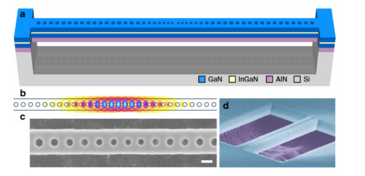Stefan T. Jagsch, Noelia Vico Triviño, Frederik Lohof, Gordon Callsen, Stefan Kalinowski, Ian M. Rousseau, Roy Barzel, Jean-François Carlin, Frank Jahnke, Raphaël Butté, Christopher Gies, Axel Hoffmann, Nicolas Grandjean and Stephan Reitzenstein.
Nature Communications(2018) 9, article number: 564.
http://dx.doi.org/10.1038/s41467-018-02999-2
Exploring the limits of spontaneous emission coupling is not only one of the central goals in the development of nanolasers, it is also highly relevant regarding future large-scale photonic integration requiring energy-efficient coherent light sources with a small footprint. Recent studies in this field have triggered a vivid debate on how to prove and interpret lasing in the high-β regime. We investigate close-to-ideal spontaneous emission coupling in GaN nanobeam lasers grown on silicon. Such nanobeam cavities allow for efficient funneling of spontaneous emission from the quantum well gain material into the laser mode. By performing a comprehensive optical and quantum-optical characterization, supported by microscopic modeling of the nanolasers, we identify high-β lasing at room temperature and show a lasing transition in the absence of a threshold nonlinearity at 156 K. This peculiar characteristic is explained in terms of a temperature and excitation power-dependent interplay between zero-dimensional and two-dimensional gain contributions.


